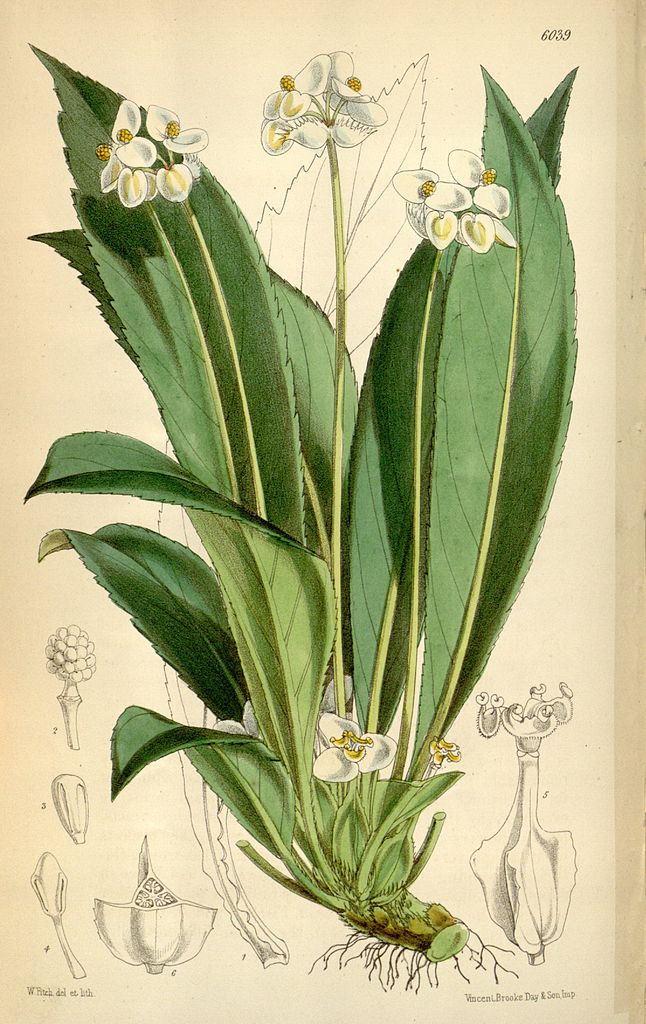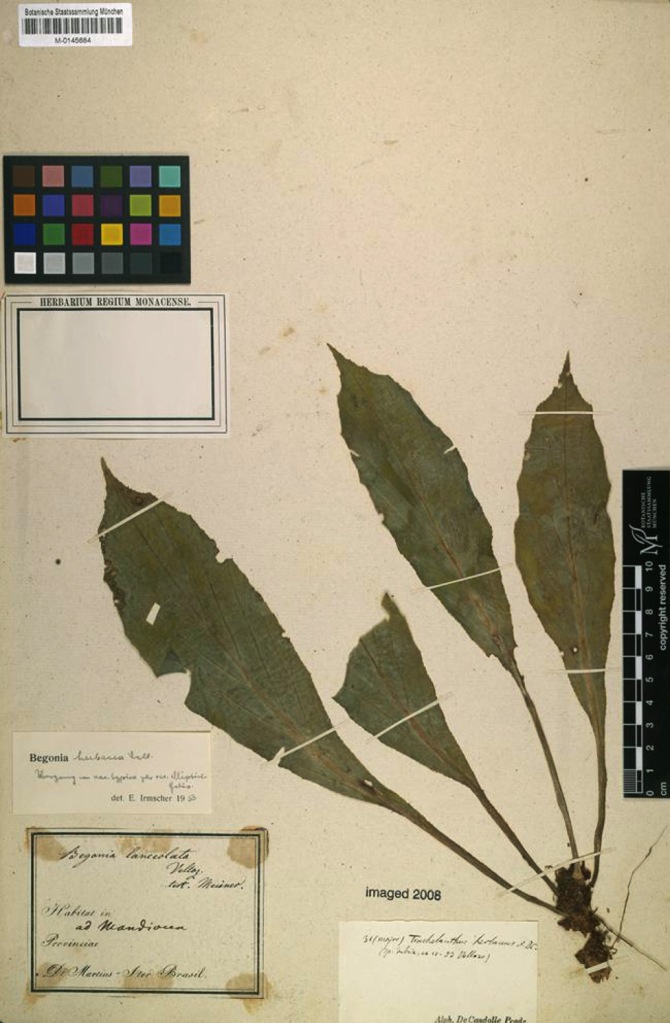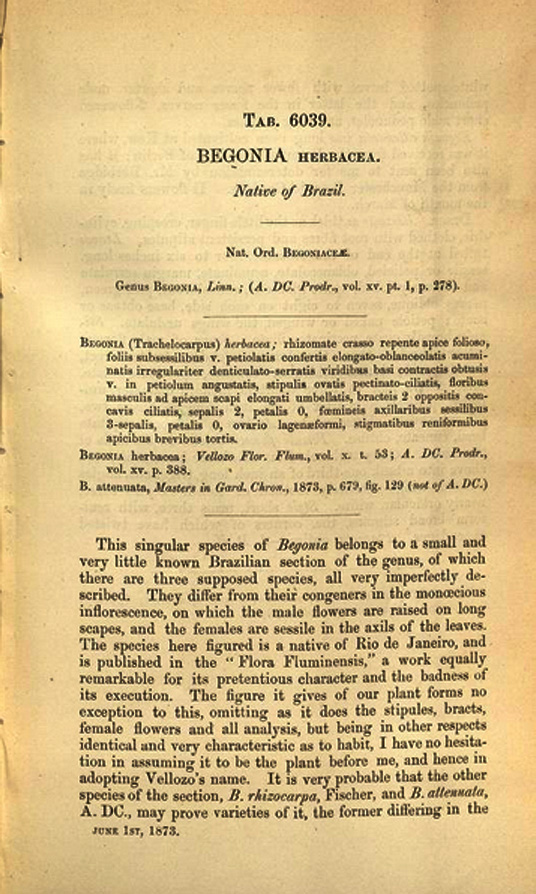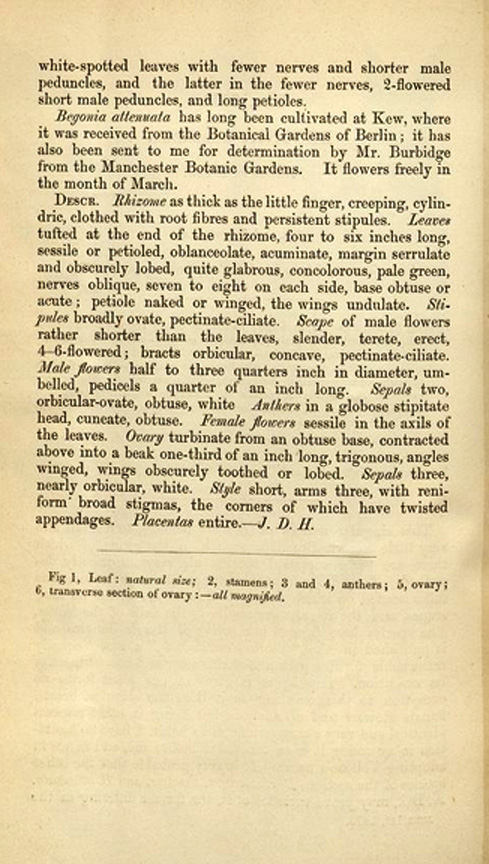
Sans aucune certitude, je pense que la plante a été découverte par Carl Friedrich Philipp von Martius, entre 1817 et 1820 lors de son séjour au Brésil, dans la région de Mandiocca. C’est en tout cas les spécimens les plus anciens que j’ai retrouvé.

Plante dénommée pour la première fois dans Florae Fluminensis Icones Vol 10 planche 53, en 1827 par José Mariano da Conceição Velloso (1742-1811). L’épithète spécifique herbacea signifie « herbacée » pour cette plante endémique du Brésil.
L’espèce fait partie de la section Trachelocarpus. Trachelocarpus (trachela « cou » + carpus « fruit »), indique pour cette section la situation particulière des parties de la fleur femelle par rapport au fruit ou à l’ovaire qui sont séparés par un allongement inhabituel.
![]()
En 1873, la plante est décrite par Joseph Dalton Hooker dans le Curtis’s botanical magazine volume 99 (série 3, volume 29) planche 6039 (voir la planche en haut de page).


En 1944, Alexander Curt Brade désigne la plante comme Begonia attenuata var. herbacea (Vell.) Brade dans le Boletim do Museu Nacional de Rio de Janeiro. Botanica volume 1, numéro 7.
En 1953, dans Botanische Jahrbücher für Systematik, Pflanzengeschichte und Pflanzengeographie Vol. 76 page 38 Edgar Irmscher a décrit deux sous-espèces :
B. herbacea var. ellipticifolia Irmsch.
B. herbacea var. typica Irmsch et B. herbacea var typica fo. minor Irmsch.
Il existe également plusieurs formes locales, j’en cultive certaines, entre autres, de Mogli das Cruzes, Salesopolis ou Teresopolis.
En septembre 1959, à l’occasion d’une suite d’articles sur les Begonias brésiliens, Moyses Kuhlmann consacre plusieurs pages à cette espèce dans The Begonian volume 26, numéro 9, pages 196, 197 et 209.



On rencontre cette espèce dans la forêt ombrophile de la mata Atlantica dans les régions de Rio de Janeiro, Paraná, et Santa Catarina.
A permis de créer les cultivars B. ‘Ever Reddy’, B. ‘Pink African Violet Begonia’ et B. ‘Speckled Spear’ de Leslie Woodriff en 1978, ou B. ‘Midge’ de Belva Nelson Kusler en 1976, entre autres.
Je sais qu’il existe un Begonia (socotrana x herbacea) dont je n’ai jamais vu ni description, ni photo.
Dans cette section, on trouve également Begonia angraensis, Begonia depauperata, Begonia lanceolata et Begonia rhyzocarpa.
Les espèces de cette section croissent et vivent attachées aux troncs des arbres, sans aucun contact avec le milieu environnant, et, de la même manière que les orchidées, les broméliacées et une infinité d’autres plantes épiphytes, ces bégonias ne prennent rien aux arbres auxquels ils s’accrochent. Ils peuvent donc continuer à vivre sur des troncs morts et se développer admirablement sur le « xaxim » (Fougère géante arbustive). Espèce rhizomateuse de 25 centimètres de haut, dont une autre particularité sont les feuilles symétriques et lancéolées, avec une transition presque imperceptible entre la base longtemps atténuée de la feuille et le rhizome, tellement le pétiole est discret. Les fleurs mâles sont en inflorescences de 5 à 7 fleurs blanc crème. Les fleurs femelles sont solitaires, floraison en fin d’hiver.

La multiplication se fait facilement pas semis, division des souches.
Je cultive les jeunes plantes dans un substrat composé uniquement de compost à demi décomposé de feuilles et de frondes de fougères. Quand les plantes peuvent être mise en place, je les installe sur des branches couvertes de mousses, mais on peut utiliser des troncs de fougères arborescentes, ou des coques de noix de coco…
Les taches argentées des feuilles deviennent plus évidentes et les fleurs presque blanc neige sur les spécimens cultivés à l’ombre. Lorsque la plante est exposée au soleil, les taches ne sont pas aussi claires et les bords des fleurs, ainsi que le dos de la feuille deviennent teintés de rouge ou de rose.
Без сомнений, это растение было найдено ботаником Carl Friedrich Philipp von Martius между 1817 и 1820 в Бразилии в районе MandioccaБ Это самый древний экземпляр, который я обнаружил. Растение было описано в Florae Fluminensis Icones том10 – 53, в 1827 ботаником José Mariano da Conceição Velloso (1742-1811). Эпитет herbacea означает травянистое растение, произрастающее в Бразилии.
Этот вид относится к разделу Trachelocarpus. Trachelocarpus (trachela « шея » + carpus « фрукт »), в котором завязь и плод в женских цветках разделены необычно длинном соединением.
В 1873, растение было описано ботаником Joseph Dalton Hooker в журнале Curtis’s botanical том 99 ( 3, 29) рис 6039 (см иллюстрацию вверху страницы).
В 1944, Alexander Curt Brade дает этому растение название Begonia attenuata var. herbacea (Vell.) в Boletim do Museu Nacional в Rio de Janeiro. Журнал Botanica том 1, 7.
В 1953, в издении Botanische Jahrbücher für Systematik, Pflanzengeschichte und Pflanzengeographie том. 76 стр 38 Edgar Irmscher описывает два подвида:
Begonia herbacea var. ellipticifolia Irmsch и Begonia herbacea var. typica Irmsch.
Имеются многочисленные местные подвиды, я выращиваю некоторые из них ( Mogli das Cruzes, Salesopolis ou Teresopolis).
В сентябре 1959, в статьях, посвященных Begonias brésiliens, ботаник Moyses Kuhlmann посвящает несколько страниц этому растению в The Begonian том 26, номер 9.
Этот вид встречается в тенистых лесах в районах Rio de Janeiro, Paraná и Santa Catarina.
В 1978 был выведен подвил B. ‘Pink African Violet Begonia’ de Leslie Woodriff , а в 1976 B. ‘Midge’ de Belva Nelson Kusler.
В этом же разделе имеются Begonia attenuata, Begonia lanceolata и Begonia rhyzocarpa.
Эти растения растут, взбираясь по стволу деревьев, без всякой другой связи с окружающей растительностью, также как орхидеи, бромелиевые и другие виды эпифитов. Так как они ничего не потребляют от стволов еревьев, бегонии могут жить даже на сухих стволах, а также на « xaxim » (Гиганский папоротник). Вид rhizomateuse 25 см в высоту, с листьями симметричными и ланцетовидными, с таким незаметным переходом между основанием листа и корневищем, что стебель практически незаметен. Мужские цветки состоят из соцветием из 5-6 цветов кремовой расцветки. Женские цветки одиночные, цветение в конце зимы.. Я выразива это растение из семян,
Разведение семенами или разделением стеблями
Я выращаваю молодые растения в субстрате из компоста из листьев папоротника. Когда растение достигает размера, чтобы его можно было высаживать, я его прикрепляю к веткам, покрытым мхом. Но можно использовать также стволы деревообразных папоротников или скорлупу кокосового ореха.
Серебристые пятна на листьях становятся более заметными, а листья практически белыми на растениях, выращиваемых в тени. Когда растение находится на свету, эти пятна не такие светлые, а сам лист, а также его обратная сторона красного или розового цвета.
.
.
.
Without any certainty, I think that the plant was discovered by Carl Friedrich Philipp von Martius, between 1817 and 1820 during his stay in Brazil, in the region of Mandiocca. In any case, the oldest specimens I found.
Plant named for the first time in Florae Fluminensis Icones Vol 10 plate 53, in 1827 by José Mariano da Conceição Velloso (1742-1811). The specific epithet herbacea means « herbaceous » for this plant endemic to Brazil.
This species belongs to the section Trachelocarpus (trachela « neck » + carpus « fruit »), indicates for this section the particular situation of the parts of the female flower with respect to the fruit or the ovary which are separated by an unusual elongation.
In 1873, the plant is described by Joseph Dalton Hooker in Curtis’s botanical magazine volume 99 (series 3, volume 29) plate 6039 (see the board at the top of the page).
In 1944, Alexander Curt Brade refers to the plant as Begonia attenuata var. herbacea (Vell.) Brade in the Boletim do Museu Nacional de Rio de Janeiro. Botanica volume 1, number 7.
In 1953, in Botanische Jahrbücher für Systematik, Pflanzengeschichte und Pflanzengeographie Vol. 76 page 38 Edgar Irmscher described two subspecies:
Begonia herbacea var. ellipticifolia Irmsch
Begonia herbacea var. typica Irmsch.
There are also several local forms, I cultivate some, among others, Mogli das Cruzes, Salesopolis or Teresopolis.
In September 1959, in a series of articles on Brazilian Begonias, Moyses Kuhlmann devotes several pages to this species in The Begonian volume 26, number 9.
This species is found in the rainforest of Mata Atlantica in the Rio de Janeiro, Paraná, and Santa Catarina regions.
Created Leslie Woodriff‘s cultivars B. ‘Ever Reddy’, B. ‘Pink African Violet Begonia’ and B. ‘Speckled Spear’ in 1978, or B. ‘Midge’ by Belva Nelson Kusler in 1976, among others.
In this section, we also find Begonia attenuata, Begonia lanceolata and Begonia rhyzocarpa.
The species of this section grow and live attached to the trunks of the trees, without any contact with the surrounding environment, and in the same way as orchids, bromeliads and an infinity of other epiphyte plants, these begonias take nothing from trees. to which they cling. They can therefore continue to live on dead trunks and develop admirably on the « xaxim » (giant shrub fern). A rhizomatous species 25 centimeters high, another characteristic of which are the symmetrical and lanceolate leaves, with an almost imperceptible transition between the long attenuated base of the leaf and the rhizome, so the petiole is discreet. The male flowers are in inflorescences of 5 to 7 creamy white flowers. The female flowers are solitary, blooming in late winter.
The multiplication is easily done not sowing, division of the strains.
I grow the young plants in a substrate composed only of compost half-decomposed leaves and ferns fronds. When the plants can be put in place, I install them on branches covered with moss, but one can use trunks of tree ferns, or shells of coconut …
The silvery patches of the leaves become more obvious and the flowers almost snow-white on the specimens grown in the shade. When the plant is exposed to the sun, the spots are not so clear and the edges of the flowers, as well as the back of the leaf become tinged with red or pink.

2 réflexions sur “Begonia herbacea”